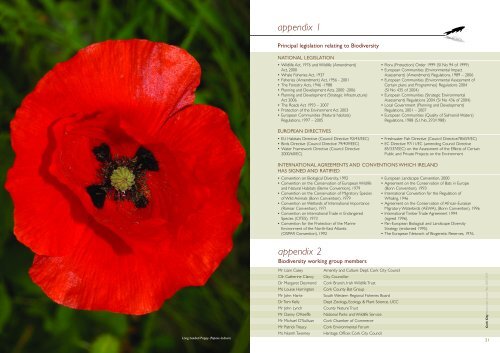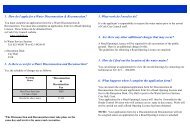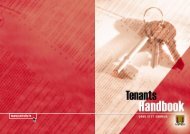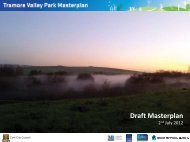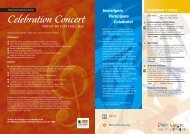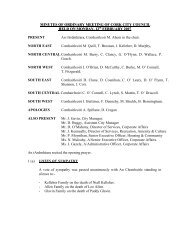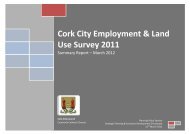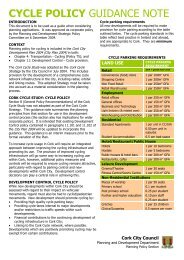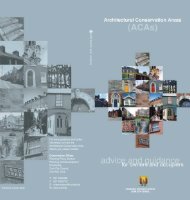Cork City's Biodiversity Action Plan - The Heritage Council
Cork City's Biodiversity Action Plan - The Heritage Council
Cork City's Biodiversity Action Plan - The Heritage Council
You also want an ePaper? Increase the reach of your titles
YUMPU automatically turns print PDFs into web optimized ePapers that Google loves.
Did you know?<strong>Cork</strong> Harbour Bird Atlas -http://corkharbourbirds.ucc.ie/contains information on25 years of bird countsundertaken by volunteersacross <strong>Cork</strong> Harbourincluding Douglas Estuary.This interesting resourcewas created by the Coastaland Marine ResourcesCentre of UCC.<strong>Cork</strong> LoughFurther inland, <strong>Cork</strong> Lough is a shallow freshwater lake of around 6 hectares in size,surrounded by amenity grassland and trees. <strong>The</strong> southern section of the Lough is dominatedby an island covered in willow trees. <strong>The</strong> Lough is a proposed Natural <strong>Heritage</strong> Area and aWildfowl Sanctuary and, apart from being an important public amenity area, is a truebiodiversity gem within the heart of the city.<strong>The</strong> most visible biodiversity feature of the Lough is the wildfowl.While the island provides saferefuge and roosting places, many birds interact regularly with humans and provide people witha chance to get up really close to nature. In total, 82 bird species have been recorded from theLough; numbers of regular and resident birds enhanced by occasional records of rare orunusual species. <strong>The</strong> Lough’s proximity to the coast and to Kinsale Road Landfill Site oftenresults in the area being visited by many different gulls, with fourteen different gull specieshaving been recorded there to date.<strong>The</strong> Lough is truly a special place and attracts and amazesboth serious bird watchers and local children alike.Another important element of the Lough’s biodiversity are fish. Historically famous for itsfishery value and today a popular angling spot, species range from Eels (Anguilla anguilla) thatwere probably present naturally, to more recent introductions such as Carp (Cyprinus carpio)and Pike (Essox lucius).<strong>The</strong> dominant fish species within the Lough are Carp which were introduced in the 1950’s andwhich now have a high angling amenity value. Indeed, the Irish record Carp, weighing 29lb14oz, was caught by Sidney Kennedy at <strong>Cork</strong> Lough in 1998.Did you know?<strong>The</strong> <strong>Cork</strong> Lough IntegratedManagement Study (CLIMS)recently undertaken byUCC aims to develop aphosphorus budget for<strong>Cork</strong> Lough. Phosphoruslevels are currently high andlinked to poor water quality- the results of this <strong>Cork</strong>City <strong>Council</strong> funded projectwill enable a managementplan to be developed forthe Lough which willultimately enhance its valuefor both biodiversity andamenity purposes.Designated Sites Just Beyond the City BoundariesWe must acknowledge the proximity of important biodiversity areas that occur justoutside the City boundaries and therefore fall within the county’s jurisdiction, but playan important part in the lives of City people. Not all of these places will be formally protectedbut are important biodiversity areas in a local context.Of the designated areas just outside the city boundary, <strong>Cork</strong> Harbour is probably the mostimportant as one of the biggest natural harbours in the world and forming the backdrop tothe city and many other towns and villages. In terms of its biodiversity, <strong>Cork</strong> Harbour is themost important site on the south coast; supporting internationally important numbers ofwaterbirds and designated as a Special Protection Area, as mentioned earlier, but alsoacknowledged as a Ramsar Site and an Important Bird Area. <strong>The</strong> harbour also boasts a totaland impressive nine Natural <strong>Heritage</strong> Areas: Cuskinny Marsh, Douglas Estuary, DunkettleShore, Lough Beg, Monkstown Creek, Owenboy Estuary, Rockfarm Quarry (Little Island),Rostellan Lough, Aghada Shore and Poulnabine Inlet and Whitegate Bay. Great Island Channel(North Channel) is considered of international importance in terms of its habitats and is acandidate Special Area of Conservation under the EU Habitats Directive.<strong>The</strong> natural habitats and species of <strong>Cork</strong> Harbour continue to survive amongst the urbandevelopment, industry and shipping.<strong>The</strong> flora and fauna range from those attached to, or livingwithin or on the bottom sediments of the seabed (known as benthos), to tiny, microscopicplants that live in the water column (known as phytoplankton) to the larger and more obviousfish, birds and marine mammals such as the Common Dolphin (Delphinus delphis). All have animportant part to play in the marine food chain and natural cycling of the harbour and manyaspects of this biodiversity are important from an economic standpoint, for example, seafisheries and aquaculture.<strong>Cork</strong> City <strong>Biodiversity</strong> <strong>Action</strong> <strong>Plan</strong> 2009-2014Birds of <strong>Cork</strong> Lough (Regularly observed/resident species)Black-headed Gull (Larus ridibundus)Mallard (Anas platyrhynchos)Canada Goose (Branta Canadensis)Mediterranean Gull (Larus melanocephalus)Common Gull (Larus canus)Moorhen (Gallinula chloropus)Coot (Fulica atra)Mute Swan (Cygnus olor)Cormorant (Phalacrocorax phalacrocorax) Oystercatcher (Haematopus ostralegus)Goldeneye (Bucephala clangula)Pochard (Aythya ferina)Great Black-backed Gull (Larus marinus) Shelduck (Tadorna tadorna)Grey Heron (Ardea cinerea)Shoveler (Anas clypeata)Greylag Goose (Anser anser)Snipe (Gallinago gallinago)Herring Gull (Larus argentatus)Teal (Anas crecca)Lesser Black-backed Gull (Larus fuscus)Tufted Duck (Aythya fuligula)Little Grebe (Tachybaptus ruficollis)<strong>The</strong> Fish of <strong>Cork</strong> Lough (Regularly observed/resident species)Carp (Cyprinnus carpio)Pike (Essox lucius)Eel (Anguilla anguilla)Rudd (Scardinius erythrophthalmus)Perch (Perca fluviatilis)Tench (Tinca tinca)Starling (Sturnus vulgaris) nesting in wallFrom its source at Gougane Barra on the<strong>Cork</strong>/Kerry border to the <strong>Cork</strong> CityWaterworks, near the Lee Fields, the River Leeis designated as a Salmonid River under theEU Freshwater Fish Directive, under whichIreland is obliged to protect the species via themaintenance of good water quality. <strong>The</strong> Lee is65km long and drains an area of about 1,200km 2 and defines a major part of the county aswell as the city landscape. <strong>The</strong> northern banksof the River Lee and associated habitats, justupstream of the City boundary are also partof the proposed Lee Valley Natural <strong>Heritage</strong>Area which supports a range of semi-naturalhabitats including wet and dry broadleavedwoodland and freshwater marsh. <strong>The</strong> RiverLee adds a unique element to the biodiversityof <strong>Cork</strong> City with many rare or protectedspecies found along its length including Brookand Sea Lampreys (Lampetra planeria andPetromyzon marinus), Kingfisher (Alcedo atthis)and Salmon (Salmo salar).<strong>Cork</strong> City <strong>Biodiversity</strong> <strong>Action</strong> <strong>Plan</strong> 2009-201489


